
|
Today's Calendar |
| | Simply Economics |
| | International Perspective |
| | Resource Center |
 |
|
| 1999 Articles |
|
By Evelina M. Tainer Chief Economist, Econoday Quiet holiday week with strong economic data
Quiet trading week 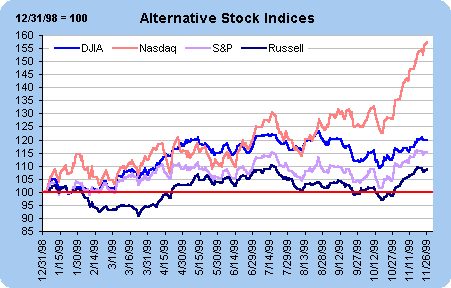 The Dow, the S&P 500 and the Russell 2000 generally moved in tandem, maintaining their recent differences in growth rates. It is interesting to see how meager these gains look compared with the NASDAQ composite. Yet, after the strong showing for the past several years, the S&P 500 and the Dow are posting respectable gains to date.
Treasury yields drift higher in thin markets 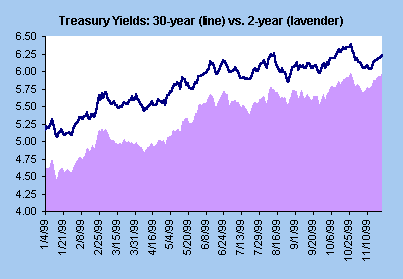
Real GDP growth revised higher for Q3:99 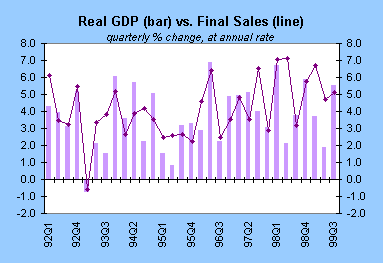 The upward revision in final sales was due primarily to gains in personal consumption expenditures and a smaller deterioration in the net export deficit. Although exports were revised lower, the downward revision in imports was far greater - and this helped reduced the third quarter's shortfall. Residential and nonresidential investment were revised up, but expenditures on equipment and software were revised down. Nevertheless, this latter category still grew at a whopping 18.2 percent rate for the period. The implicit price deflator was revised up a tick to increase at a 1.1 percent rate in the third quarter. Although slightly higher than initially estimated, the third quarter pace was still lower than the first half of the year - which saw the lion's share of energy price hikes. On a year-over-year basis, the gains are still moderate as well. The chart below compares yearly changes in the GDP deflator to the employment cost index.  The GDP report included the Commerce Department's first pass at corporate profits for the quarter. After-tax profits increased at a 12.4 percent clip in the third quarter compared with the second quarter. After-tax profits rose 11.7 percent from a year ago. It is worth noting that profits had weakened at the end of 1998 so year-to-year comparisons are favorable. 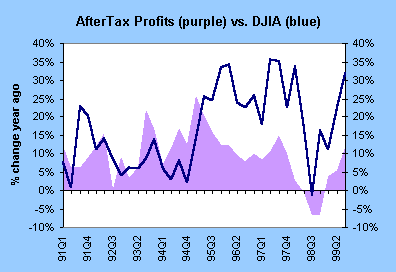 The bottom-line on growth, inflation and profits? The Federal Reserve had tightened monetary policy last week in order to stem the growth in the economy. Clearly, the upward revision for third quarter GDP will not be viewed in a favorable light. Yet, the Fed knows that this partly reflects inventory stockpiling in advance of potential Y2K disruptions. Inventories are likely to be run down in the first half of 2000. The Fed would be relieved if consumer expenditures continue their trend of slower growth. Corporate profits have improved in the past three quarters. Indeed, the yearly gains in profits mirror the year-over-year gains in stock prices (as measured by the Dow Jones Industrials Average). Profit gains will have to accelerate in order for continued acceleration in stock prices going forward. The price deflator has moderated this past year suggesting that inflation remains under control thus far despite tight labor markets and robust economic activity.
Income and consumption surge 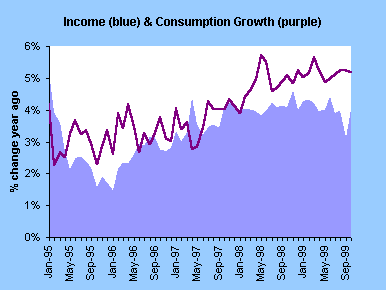 Personal consumption expenditures rose 0.6 percent in October, in line with the pace of the past several months. Given the special factors in income, this allowed the personal saving rate to rebound during the month after a drop in September. Nevertheless, the chart above shows the large gap between income and consumption growth. Unless these become more closely aligned, the saving rate will continue its downward descent. The bottom-line on income and spending? Fed officials were hoping to see some moderation in the rate of consumer expenditures. This certainly didn't happen in October. It will take a few months before the impact of the most recent rate hike is felt. Since the Fed is not likely to make any policy changes before February 2000, several months worth of data may still be available to reflect slower growth.
Federal budget deficit starts new fiscal year on lower note 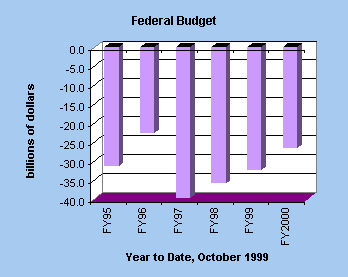 The Treasury received a 5.4 percent gain in the level of individual income tax receipts this October. Clearly, that reflects the continuation of a strong income trend. Perhaps even more interesting is the 24 percent hike in corporate income taxes for the month. Despite these sharp gains in these two key components, total receipts were only 0.9 percent higher than a year ago due to a shortfall in excise taxes. Total outlays were down 3.1 percent from a year ago. In particular, outlays for Medicare plunged 18.3 percent for the month. Expenditures for defense items decreased, as did interest costs. Among major components, only social security payments rose from last year's levels. The bottom-line on the federal budget? The investment community has long held that a reduction in government borrowing would be good for the U.S. economy. Indeed, the continued reduction of the federal debt will help to alleviate the need for Treasury borrowing. That means that the Treasury will issue fewer securities - such as 2-year and 5-year notes or 30-year bonds. Fewer securities mean that their prices will increase, given strong demand, and their yields will decline. If you hold Treasury securities, you may find that their value has appreciated (depending on when they were purchased, of course). Federal government agencies such as Fannie Mae and Freddie Mac have already increased the issuance of their securities in order to take up the slack. Agency securities don't have the same risk-free quality of Treasuries, but are virtually risk-free. Both agencies have announced a timetable for the issuance of securities for next year.
THE BOTTOM LINE Durable goods orders posted the second straight monthly drop which may signal softer manufacturing activity in coming months. It is debatable, though, because the decline in computer orders could be related to the shortage of motherboards, which were affected by the Taiwan earthquake. Some analysts also thought sales would pick up after the beginning of the year. Weekly chain store sales are running below plan. This could indicate some moderation on the part of consumers. Only time will tell - it is still early in the holiday season.
Looking Ahead: Week of November 29 to December 3
Monday
Tuesday Economists are predicting that The Conference Board's consumer confidence index will rise about three points in November to 133.5. This reflects the improvement in the stock market over the past several weeks after the temporary malaise in October.
Wednesday The index of leading indicators is expected to remain unchanged in October, after decreasing 0.1 percent in September. This index has remained virtually unchanged over the past several months and perhaps reflects a soggy manufacturing sector. It is certainly inconsistent with the booming growth we have seen this year. Market participants are looking for a modest 0.2 percent gain in construction expenditures in October. This would be slightly smaller than the 0.5 percent increase posted last month and pretty much offset the August decline. As housing starts moderate, we should see much smaller increases - or even outright declines - in construction expenditures in the next several months.
Thursday Economists are predicting new home sales will jump 7.3 percent in October after September's 12.8 percent plunge. At least a portion of the September drop could be attributed to the negative impact of Hurricane Floyd. The downward trend in home sales could continue, however.
Friday Factory orders are expected to dip 0.5 percent in October, more than reversing the previous month's gain. At the same time, manufacturers' inventories should rise 0.5 percent, faster than the previous month. This is in line with the view that producers are stockpiling inventories in advance of yearend to avoid disruptions. |
|||||||||||||||||||||||||||||||||||||||||||||||||||||||||||||||||||||||||||||||||||||||||||